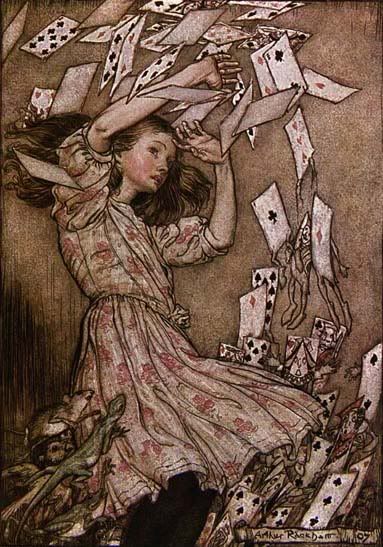(4 pm. – promoted by ek hornbeck)
entelechy
en-TEL-uh-kee\ , noun;
1. A realization or actuality as opposed to a potentiality.
2. In vitalist philosophy, a vital agent or force directing growth and life.
My husband pecks my cheek and heads off through the cacophony of clanging metal, buzzers, and ringing bells that is his playground. We are on the road, and have forgotten to get cash for lunch. It would be an easy crisis to remedy, but it gives him an opportunity to show off his talent. I stand at the edge of the action, unable to banish my ill ease at seeing the money in our pockets put at risk so he can exercises his inexplicable power.
He cruises up and down the rows of noisy machines, looking from side to side. Other patrons sit with their backs to him, focused on their own trials with fate. A Native American woman offers him a drink, but he declines. Instead, he tilts his head, like a spaniel listening to a whistle pitched too high for the human ear. He turns away from her, and takes a seat in front of a one armed bandit. In five pulls, the machine gives up its bounty with the loud clang of coins dropping into the metal tray below the spinning symbols of fruit. He scoops up the riches and stalks another machine. Eight pulls later he has enough for both our meals at the best restaurant in the casino.
 The first time he did this, the logical one in the family informed him that he was playing into the casino’s evil plan by deluding himself that he had some sort of gift. The house plays the odds, which clearly can not be altered. He might win here and there, but, over time, they have the better odds, and will always get more money than they give. Now, I have seen him do it so many times, I no longer try to make my case.
The first time he did this, the logical one in the family informed him that he was playing into the casino’s evil plan by deluding himself that he had some sort of gift. The house plays the odds, which clearly can not be altered. He might win here and there, but, over time, they have the better odds, and will always get more money than they give. Now, I have seen him do it so many times, I no longer try to make my case.
As it turned out, science weighed in on the talents of gamblers and handed the logical one her ass in the process. Not only is my husband right to believe that he can sense a gambling machine about to pay out, but part of his talent is probably altering the odds that it will pay with nothing more than the power of his resolve.
So shove that testy white rabbit out of the way, and follow the girl with the apron down the hole. On this day of resolutions, I am taking you on a walk through the Wonderland of science. Today, we peer into the power of intent.
The Gambler:
“We live on a placid island of ignorance in the midst of black seas of infinity, and it was not meant that we should voyage far. The sciences, each straining in its own direction, have hitherto harmed us little; but some day the piecing together of dissociated knowledge will open up such terrifying vistas of reality, and of our frightful position therein, that we shall either go mad from the revelation or flee from the deadly light into the peace and safety of a new dark age.”–Howard Phillips Lovecraft, 1926
1933, Duke University, North Carolina:
“Preposterous!” The man seated before Dr. J. B. Rhine was well appointed. He wore the latest fashions and carried a hand carved walking stick with an ivory handle. If gambling was indeed the man’s profession, he was clearly at the top of his game. But what he suggested was an obvious rouse.
 “Perhaps,” the man flashed a wry smile. “Nevertheless, I stand ready to prove my assertion by any means you choose. I can make the dice obey my command. I approach you seeking only verification and scientific explanation.”
“Perhaps,” the man flashed a wry smile. “Nevertheless, I stand ready to prove my assertion by any means you choose. I can make the dice obey my command. I approach you seeking only verification and scientific explanation.”
Dr. Rhine was brusk, feeling his patience tested by such a ridiculous claim, “What do you gain from this?”
“Obviously, I have nothing to gain. Confirmation of these skills would destroy my career. That’s why I must insist on anonymity.”
“Why, then? Why seek my assistance to prove what you can not admit to anyone?”
The man stared off through the window, twirling his walking stick absentmindedly. “I have reason to believe I am not unique. I suspect that there are many with this ability. I want to know how many.”
Professor Rhine knelt on the floor five feet from the gambler, and threw a pair of dice. His subject concentrated and double sixes came up. He threw again. Again a pair of sixes. Though double sixes did not always topple out of his hand, the man was able to influence that pair of dice, and several other pairs, in a statistically significant way.
Rhine developed elaborate mechanisms for dropping the dice to prevent his gambler from tampering with them. He experimented with volunteers, to discover they also had this ability, but less well honed than his initial gambler. He discovered the skill had no learning curve, indicating the ability was likely instinctual. The heart rate of his subjects increased with the effort and they fatigued: Their power to manipulate the world through thought waned as they repeated the experiments in rapid succession without a rest break. Energy was clearly required to exercise this talent.
Rhine published his findings in The Reach of the Mind (1947). Scientists scoffed at his ground breaking studies, and he was soon forgotten.
A Forbidden Fruit:
“Sit down before fact as a little child, be prepared to give up every preconceived notion…or you shall learn nothing.”–T. H. Huxley
When Brenda Dunne, a psychology student, approached Professor Robert Jahn, head of engineering, for help with her experiment, Jahn replied, “We can’t do that kind of thing at Princeton.”
She persisted, and Jahn finally built Murphy. Fashioned after a Japanese gambling game called Pachinko, the machine dropped 9000 balls from a hole in the top. The balls fell randomly into 19 bins in a bell shaped curve with the most being directly under the drop. Volunteers, including random people passing by the door of the office, were asked to concentrate on making the balls go left or right. The balls in each bin were then counted. Surprisingly, the volunteers were capable of altering the distribution of the balls at will.
Intrigued, Professor Jahn teamed up with Ms. Dunne and founded the Princeton Engineering Anomalies Research Institute (PEAR). He built an electronic random event generator (REG) using the radioactive decay of an isotope to produce random electronic coin flips at a rate of 100-1000 per second.
Subjects were asked to make the average number of “heads” either higher or lower than the mean. Then they were asked not to concentrate on either direction so an average could be obtained with the subject in the room. Again, people showed an ability to influence the numbers simply by thinking about them. Interestingly, when asked not to concentrate on a high or a low, the “control” bell curve was abnormally narrow and centered over the mean. Even when the subjects were not concentrating on altering reality they seemed to be influencing it anyway.
Further experiments showed test subjects capable of influencing water splatters and the direction of a swinging ball on a chain. Not just inanimate objects could be influenced. Subjects were shown to determine the swimming direction of protozoans, the creeping direction of crabs, the speed of bacterial growth, and the industry of ants.
Still others showed our ability to self reward or see the future:
In another experiment, the students were shown an image of two curtains on a computer screen and told one concealed an erotic picture. The students chose the curtain hiding the naughty picture slightly more often than could be explained away by chance, this week’s New Scientist reports.
Importantly, the position of the picture was randomly allotted by a computer which didn’t make its decision until after the volunteer chose one curtain or the other.
To believers in the paranormal, this suggests the students were actually influencing future events.–Daily Mail
In all these experiments, similarities began to emerge. The average person can alter probability 5% to 10%–a huge advantage at the poker table. A relaxed, informal environment produced more success than a formal, tense one. Subjects with confidence in their power, could alter their odds more readily than those who believed they could not. In fact animals, who apparently don’t suffer the same insecurities as Man, are experts at this skill.
Note where these experiments took place: Cornell, Duke, and Princeton; some of the top universities in the US. At one point, the random number generator was housed two floors away from the subject, in a Faraday box and lead container. It would have functioned normally in a nuclear war or asteroid collision (at least until the electricity quit), but a human subject’s thoughts influenced its behavior. So many experiments have been done under such stringent conditions that the likelihood that the observed effect is not real is now down to 1 in a trillion.
Slowly, begrudgingly, with more evidence than it took to accept M theory or prove an electron can be in two places at once, the scientific community has had to accept these strange experiments as fact.
“It’s a poor sort of memory that only works backwards.”–The Queen of Hearts, Through the Looking Glass
PEAR’s experiments took an interesting turn as electronics became more compact. Random Event Generators could be held in the hand or dropped in a pocket. The researchers took their experiments to the “field”. They concealed them in places where people gathered. They discovered pair-bonded couples had power to change probability far more than either of the individuals alone. Groups focused on a single concept or purpose altered the machine’s randomness even more dramatically. Occupy Wall Street may be uniquely suited to change the world, more so, than the Republican National Debates. Take that, news media.
In 1997, PEAR took the experiments to the next logical level and morphed into The Global Consciousness Network. REGs were placed throughout the world and allowed to run continuously, flipping a cyber coin 200 times a second. The data was networked through the internet. Think of it as a global EEG machine.
Hypothesis:
Periods of collective attention or emotion in widely distributed populations will correlate with deviations from expectation in a global network of physical random number generators.In English:
We looked for situations that might produce a “group consciousness” because people would be engaged in a common focus, resulting in a kind of coherence or resonance of thoughts and emotions. For contrast, we identified other, mundane situations we predicted would not bring people to a shared focus.–GCP
They looked for events that garnered a large interest in the global population. O. J. Simpsons verdict was one of the first. A decrease in randomness was noted globally.
This work was a prelude for an attempt to register effects of the world-wide expression of compassion at Princess Diana’s funeral in September of 1997, which, coincidentally, was followed exactly a week later by the memorial ceremonies for Mother Teresa. These were prototypical “global events” for the Global Consciousness Project, in that they were the focus of a great deal of attention, and especially in the case of Princess Diana, also occasions for an unusually widespread feeling of shared compassion. —GCP
The researchers discovered global consciousness events must hold the public’s attention for at least half an hour, and be emotionally charged. The closer one is to the event, the less random the REGs behaved. Compassion is the strongest stimulus, but fear comes in a close second. Thus, the massive anti-war demonstrations prior to the US invasion of Iraq caused huge peaks in nonrandomness. Interestingly, political events, anniversaries of events, and mass meditations failed to produce such spikes.
The events of September 11, 2001 were uniquely suited for this study. It elicited both fear and compassion and held the world glued to the TV for days. The spike experienced by the researchers was unprecedented. (Graph) The odds against the peak being due to mere chance were astronomical: Another Graph.
There was something else notable about the spike. While it peaked shortly after the broadcast of the plane hitting the first tower, the curve of the spike began to rise 4 hours before the planes hit the towers. It was later dwarfed by the spike of nonrandomness that occurred 24 hours before the Indian Ocean Tsunami.
Precognition or Omnipotence?
“Science cannot solve the ultimate mystery of nature. And that is because, in the last analysis, we ourselves are part of the mystery that we are trying to solve.”– Max Planck, the Father of Quantum Mechanics
Of course, these results were interpreted as mass precognition. But remember the initial nature of these studies, one individual effecting the outcome of reality at a rate of 5-10%. The other explanation is that the peaks and valleys of global “focus” are random, but when many people focus in one direction, reality is effected, for better or worse.
Think of it like this: Every human is an arrow capable of pointing in any direction in a sphere. Usually, all our arrows point in different directions and only careful observation shows any effect at all. Certain circumstances cause our arrows to line up and create bigger effects. Occasionally, the arrows line up accidentally and that causes a feedback loop that can line up a large number of arrows. When that happens, reality can be altered in big ways. The outcome depends on the thoughts and emotions of those in alignment. The mood of the Earth, lately, has been rather apocalyptic. That might very well turn out to be a self-fulfilling prophesy.
Climbing Back Out of the Rabbit Hole:
“Our deepest fear is not that we are powerless. Our deepest fear is that we are powerful.”–Nelson Mandela
So on this day of resolutions, I call my quarters and draw you into my circle. I lift my wand and grant you what you already possess–the power to change the world.
What is it you resolve?
Oh, I almost forgot. Happy New Year!



1 comment
well done.